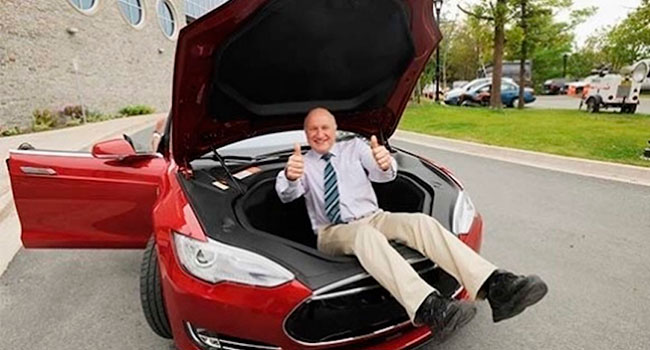 Canadians generally have no idea that Tesla’s fancy battery technology has mostly been developed in Halifax. Dalhousie University has partnered with the American electric vehicle (EV) manufacturer and created what’s commonly referred to as the Tesla Dalhousie battery lab.
Canadians generally have no idea that Tesla’s fancy battery technology has mostly been developed in Halifax. Dalhousie University has partnered with the American electric vehicle (EV) manufacturer and created what’s commonly referred to as the Tesla Dalhousie battery lab.
The new 4680 dry-cell battery is going into Tesla vehicles sometime between February and April 2021.
Here are six things, in descending order, you need to know as civilization begins a serious transformation from fossil-fuel transportation to electric vehicles.
Range
In 996 km (619 miles), one can drive from Halifax to Quebec City on a single charge. Gone are the days when people worried an EV couldn’t cover drive long distances.
The 4680 dry-cell has changed the game because gasoline and diesel cars can’t go the same distance on a tank of fossil fuels. When you’ve driven 996 km, it’s time to stretch your legs and have a meal!
Charge times
Multiple reports have indicated the 4680 charges in 15 minutes on a level-three high-speed charger.
When not charging your car at home, you’ll be able to get it done on the highway quickly for those long road trips.
Cold weather
The 4680 doesn’t have a traditional electrolyte. That means no liquid acids or gels. Liquid acids and gels don’t like cold.
The dry cell eliminates that problem, especially when combined with the heat pump Tesla developed that will become part of the automotive mainstream.
Life of battery
The days of questionable battery life from the first-generation Nissan Leaf are over. The new 4680 is good for 3.5 million km (two million miles) before it needs to be replaced.
That means it’s a game changer in not only the car business but also the long-haul trucking business.
Cost
The manufacturing time and materials required for the 4680 mean production costs will drop by 56 per cent. We’re going to see real competition on the raw sticker price at local car dealers.
Currently, 4,416 (model 2170 lithium ion) cells are placed in Tesla Model 3 or Model Y long-range edition battery packs. In contrast, only 960 cells will be required to fill the same space with the 4680.
As an added bonus, Tesla won’t have cobalt in their batteries anymore, that means no more memes about children in the Congo!
Future
You’re going to see serious discussions and planning in the long-haul trucking business because of the 4680. The development and ingenuity of ever-more-efficient batteries developed by Tesla will create mass disruption in the marketplace.
In terms of energy density (watt hours per kilogram), the standard Tesla battery has 380 Wh/kg. In five years, don’t be surprised if the 4680 dry-cell energy density increases by five per cent a year compounded from 380 Wh/kg to somewhere in the 480 Wh/kg to 500 Wh/kg range. You need 450 Wh/kg to make commercial air passenger service viable.
Let’s hope Canada and its provinces get together and create a national mining policy. We can either be part of the disruption or watch others benefit from it.
It’s time we plan for tomorrow instead of yesterday.
Clinton Desveaux writes on electric vehicles and disruption issues. He contributed this article to the Frontier Centre for Public Policy. He lives in Halifax.
Clinton is a Troy Media Thought Leader. Why aren’t you?
For interview requests, click here. You must be a Troy Media Marketplace media subscriber to access our Sourcebook.
The views, opinions and positions expressed by columnists and contributors are the author’s alone. They do not inherently or expressly reflect the views, opinions and/or positions of our publication.


